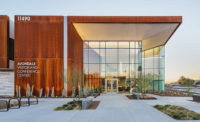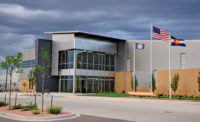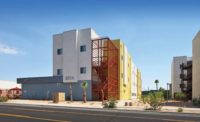2024 Southwest Best Projects
Best Government/Public Building — Courtyard Homeless Resource Center

Photo by 501 Studio Photography
Courtyard Homeless Resource Center
Las Vegas
BEST PROJECT
Submitted by: CORE Construction
Owner: City of Las Vegas
Design Firm: LGA Architects
Contractor: CORE Construction
Civil Engineer: Stanley Consultants
Structural Engineer: Mendenhall Smith Structural Engineers
MEP Engineer: TJK Consulting Engineers
Landscape Architect: Aria Landscape Architecture
With more than 5,600 individuals experiencing homelessness in the Las Vegas area, many of whom are sleeping outside in the extreme heat, the city stepped in to create a solution. The result is a 50,734-sq-ft campus that offers much needed services and support. Phased construction of three stand-alone buildings and a 22,500-sq-ft sleeping canopy was completed within budget and on time in June 2023.
Making way for the new $24.6-million facility on a 2.7-acre site required the sequenced demolition of several existing buildings. The space is now home to a two-story administration building, a guest services building and a two-story volume indoor day center.
Shade structures provide relief from Las Vegas’ extreme heat and other weather conditions and include such features as ground and ceiling fans, evaporative coolers and radiant heaters.

Photo by 501 Studio Photography
These shade structures cover an area that can house up to 1,432 people during the day. For those staying overnight, there are more than 600 beds. Unlike other shelters, Courtyard also offers animal enclosures with shade and fans for pets.
At the start of excavation, the contractor discovered extremely saturated clay soil and groundwater at shallower depths than identified in the geotechnical report.
After potholing at various locations and monitoring groundwater flow into the wells, the project team determined that none of the native material would be adequate. Through a collaborative effort, the team then designed and installed a permanent dewatering system for the entire facility.
Each building is composed of concrete block and steel with insulated metal panel exterior cladding. Although the project team chose prefabricated metal buildings to save on the budget, when it came time to construct the third and final building, it was done with a traditional steel structure. To navigate a constrained active site, the contractor also established daily temporary laydown areas and removed them at the end of each workday to avoid disrupting surrounding activities.

Photo by 501 Studio Photography
One of the facility’s unusual features is located in the day center, where small hot box rooms use heating technology to eliminate insects and germs that could be present on guests’ belongings, helping to prevent the spread of unwanted contaminants.
Throughout the project, the contractor collaborated with adjacent active homeless facilities to ensure their services remained uninterrupted during construction. Several homeless individuals were even hired to handle security oversight duties during off hours to ensure that theft or vandalism did not occur at the jobsite.
To provide a welcoming environment, the facility’s finishes include bright colors. The finishes are also extremely durable to ensure they hold up to heavy use. Ample exterior windows and tubular skylights provide natural lighting that reinforces the interior aesthetic.
Two passive and seasonal mechanical cooling towers were installed to help condition the outdoor gathering areas as well. Crews planted a wide variety of trees and plants throughout the campus, and planters around the perimeter of the sleeping canopy and between buildings serve to break up larger areas of concrete.



